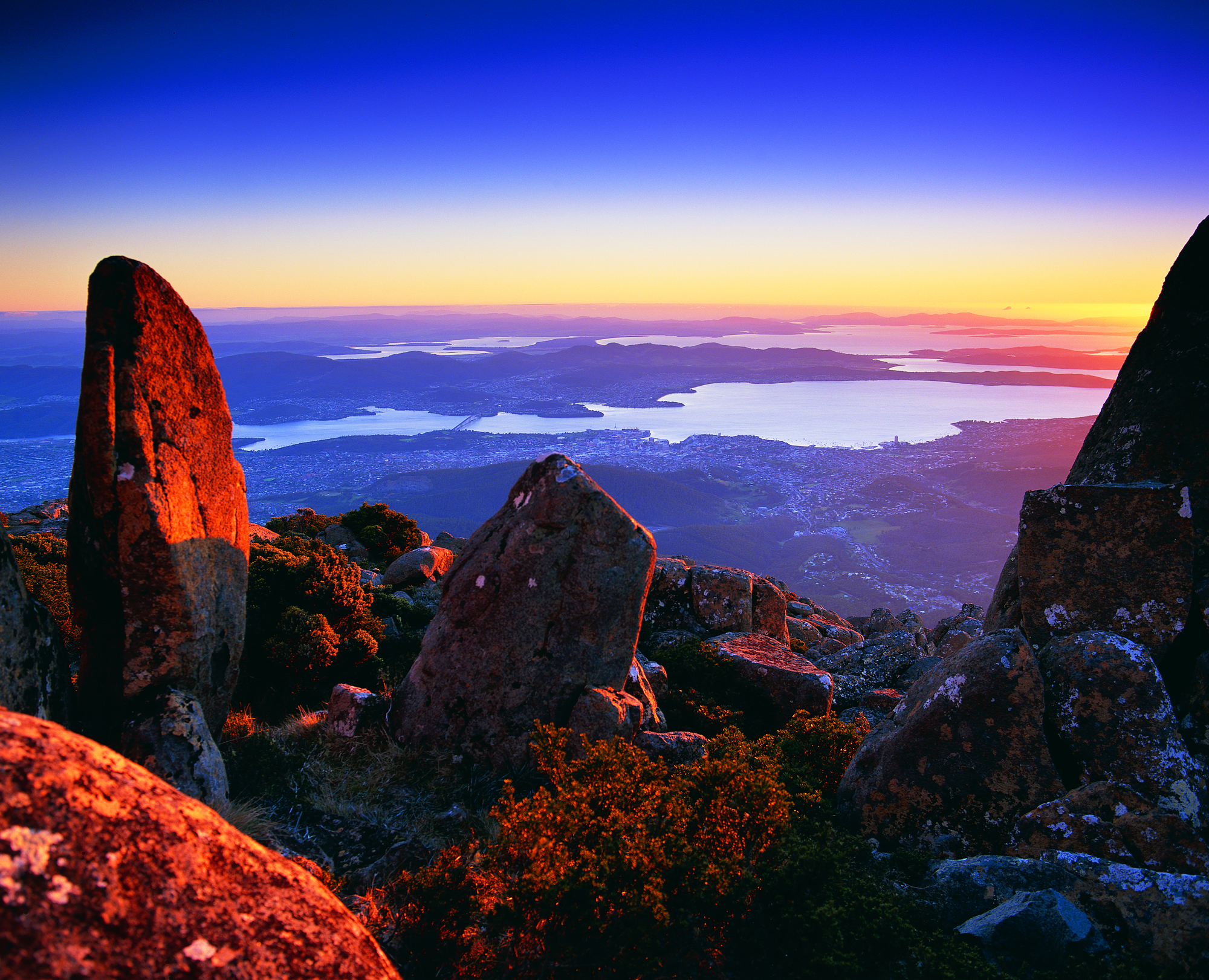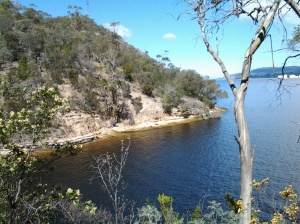Once I had walked through the East Risdon State Reserve and down the hill to the edge of the Derwent River in the suburb of Risdon, despite sore feet, I felt compelled to walk south along the water’s edge towards Tommy’s Bight. Much of my walk over the previous hour or so had not been at the edge of cliffs, so for an authentic walk along the River I liked the idea of following tracks to determine how far back south I could walk (all the while knowing I would need to retrace my steps to get to the bus stop for my return home).
I turned left into Saundersons Road from Risdon St and continued walking until, opposite the No Through Road and the 50km/hour speed signs, a gravel and dirt single-foot track led down around the water’s edge. The track seemed infrequently walked, and it was delightfully soft and gentle on my feet.
I loved listening to the lightly lapping water and my world seemed very still until three sulphur crested cockatoos screamed overhead.
At 12.50pm I arrived at a Bay, and without checking my maps, mistakenly thought I had reached Tommy’s Bight.
I had a good look around the Bay before sitting on a sunny rock to eat my lunch.
After munching I dragged out my map and discovered I had been enjoying the peace and quiet of Porter’s Bay.
Ignoring my aching feet, I began on the track towards Tommy’s Bight. When the track split into two directions, I walked uphill for a while before realising this would take me back to the top of the East Risdon State Reserve. I turned back until I could follow the track parallel to Porters Bay. The time was 1.20pm and the metal-saw whining noise from over the River was ever present.
Parts of this track were dappled with sunlight and the lack of direct searing sun was a relief. However, it was difficult to read the irregular root strewn and rocky pathway and not roll my ankles. A number of splits in the track and a mess of tracks generally all led back to the one track. Usually the detours were the result of fallen trees along the way.
It was along this track that the walk’s greatest thrill materialised.
I had never seen one before and was staggered how large it was: a perfectly camouflaged Green Rosella. With deep olive green feathers and broad tail, the bird was resting on a low branch. I stood watching for the few seconds before it flew off through the trees and disappeared. Today, as I write this blog post, I have checked the internet for photos and I am sorry to say I cannot find an image showing a bird as green as the bird I saw. I realise the Green Rosella has other colours which should have flashed at me, but they didn’t and it is the overwhelming sense of the green that I remember – even on its head (although perhaps the shadows of the green surrounding foliage led me to ‘see’ green). I feel immensely privileged to have seen this spectacular specimen.
At 1.30pm I was passing a tiny curved shell beach below and continued on to where the waters of the Derwent River and Tommy’s Bight met.
By 1.35pm the bottom of Tommy’s Bight was in full view.
Tracks on the other side of the bay made it obvious that it was possible to continue walking south. On the hill top in the distance I could see the electricity pylon against which I had walked earlier in the day. Another day, I will return to discover more.
By 1.45pm I had begun the return walk north and was back at Porters Bay and by 1.50pm I was back on the bitumen at Risdon. Only then did I notice an electricity pole on the other side of the road with its own name, ‘The Leaning Pole of Risdon’!
By the way, there are no public toilets, no cafes or restaurants, and no other facilities and services during this walk or in the suburb of Risdon. So be prepared.
The rest of my walk was undertaken on the edge of Saundersons Road as it wound around the Derwent River with Risdon’s houses on the right. I reached the bottom of Risdon St by 2pm and then continued on in full view of the Bowen Bridge further north
before passing Cleburne Street and Cemetery/Church Point Road. I reached the intersection with the East Derwent Highway at 2.10pm.
The view below was photographed at Risdon Cove looking towards the Derwent River while waiting for the bus. The suburb Risdon can be accessed to the left of the car that is seen travelling on the road. Land has been reclaimed across the Cove so that the East Derwent Highway can continue uninterrupted further north. I will walk along that road in Stage 7.
Once at the bus stop (an unnumbered bus stop) at 2.15pm, I relaxed into the wait for Metro Bus number 694 that arrived 20 minutes later. Meanwhile, I was able to take a broad view of Risdon Cove, knowing this to be the starting point for Stage 7 of my walk along the Derwent River.
On the return bus I was treated to a ride through the large and dispersed suburb of Risdon Vale located some kilometres away. This suburb sits in an open valley skirting behind Tasmania’s main prison site, the Risdon Prison Complex. ‘The mountain’ (Mount Wellington) is ever visible.
Eventually the bus turned back onto the East Derwent Highway and travelled via some suburban detours to the Eastlands Bus mall at Rosny Park on its way to Hobart. I am excited by the rich experiences offered by Stage 6 of this walk and look forward to leading friends along these paths. I hope my stories inspire others to have a look at this area or find their own walks of discovery.









Once upon a time when you were teaching in Melbourne you wrote to tell me you had seen a green dog, a pure green dog on the way to work. It was running along under the shade of some green leafy trees. So the next challenge is to see a green goanna.
LikeLike
Friend Ma sent a second message to me via email: “Green parrots-you may have seen the blue winged parrot. It is the greenest and has no red or yellow. It is a summer visitor and I see it down here at times. The female is a duller green and the blue can be very dull and its hard to pick up the blue underwing colouring in most lights. In flight I find them hard to identify.
Sea eagles-one summer I was on the beach with a friend who is an ornithologist and we were watching an amazing multi-fronted electrical storm rolling in from the south east. More amazing were the dozens of sea eagles frolicking and playing on the air currents of each front. Priscilla, who has studied sea eagles for years, said she has never seen such a phenomena. So reading your blogs brings back lots of memories as well as telling me things I never knew.”
My response is:
“I have now checked and rechecked and checked again, and I do believe the bird could only have been a green Green Rosella. The large size of the bird I saw was the defining indicator, but the colour/markings are not consistent with any photograph in my bird books or on bird sites. More research required. Nevertheless all very strange.”
LikeLike
Ma responded to this response with: ” I don’t know why the photos come up,so yellow. In real life it is much more olive green. And I checked with P and she said that the male juveniles don’t get the colour on their heads till their first mating but I am not sure when this is. So a teenage Green Rosella.” To this I responded: “That must be it. S/he was a shy teenager.”
LikeLike